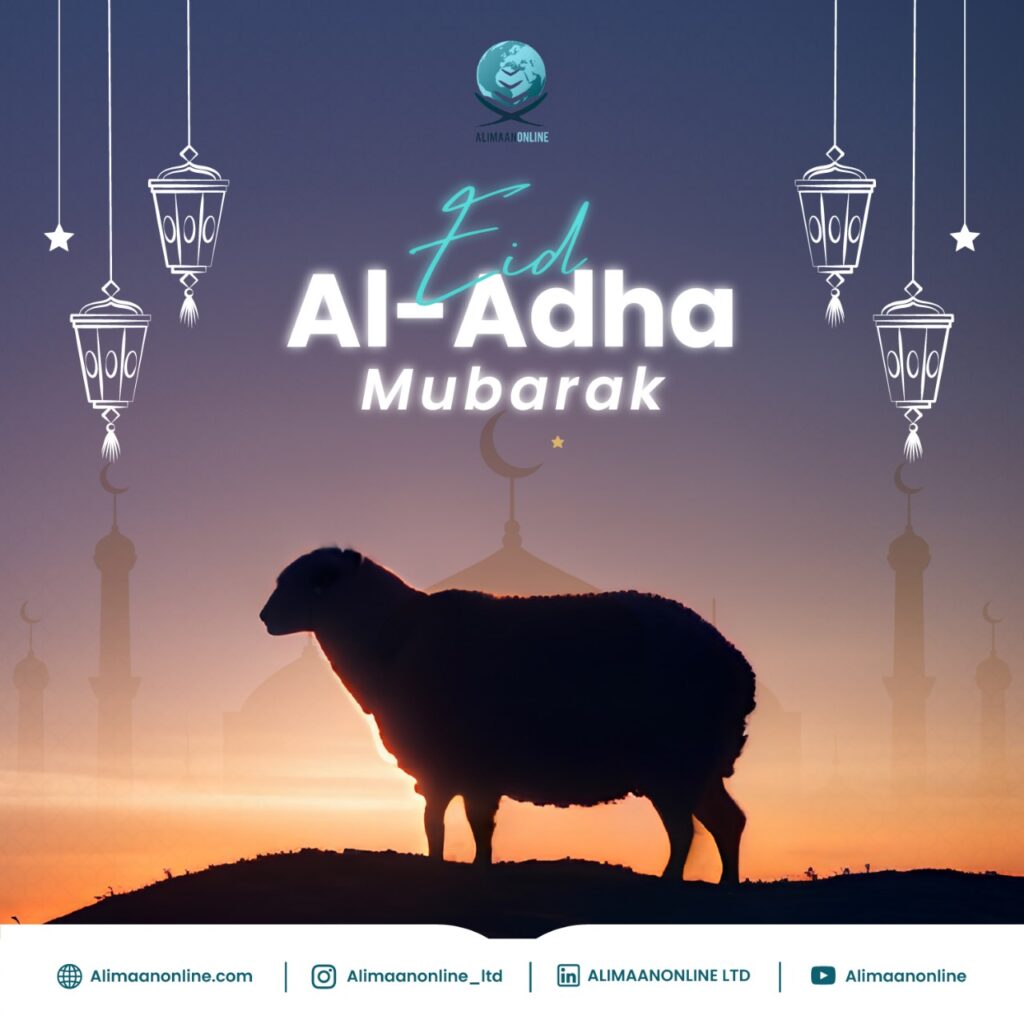Eid ul-Adha is one of the two most significant Islamic celebrations observed by Muslims across the globe. Known as the “Festival of Sacrifice,” this event honors the unwavering faith of Prophet Ibrahim (A.S.) and his willingness to sacrifice his son for Allah’s command. With deep spiritual significance and widespread communal involvement, Eid ul-Adha brings together worship, reflection, charity, and celebration.
The Meaning and Origin of Eid ul-Adha
Eid ul-Adha originates from the Qur’anic story of Prophet Ibrahim (A.S.), who had a powerful dream in which he was commanded by Allah to sacrifice his beloved son, Ismail (A.S.). Despite the emotional difficulty, Ibrahim (A.S.) submitted to the divine command, demonstrating unshakable faith. However, before the sacrifice could occur, Allah replaced Ismail (A.S.) with a ram, thus sparing his life. This event marks the foundation of Eid ul-Adha, a powerful reminder of devotion, obedience, and divine mercy.
Muslims commemorate this story annually by offering animal sacrifices and engaging in acts of worship. Over time, Eid ul-Adha has grown into a global celebration that emphasizes not only sacrifice but also generosity, empathy, and unity among Muslims.
When Is Eid ul-Adha Celebrated?
Eid ul-Adha is celebrated on the 10th day of Dhul Hijjah, the twelfth and final month of the Islamic lunar calendar. This special day also marks the climax of Hajj, the annual pilgrimage to Makkah. Because the Islamic calendar follows the lunar cycle, the Gregorian date of Eid ul-Adha varies each year, moving approximately 10–11 days earlier.
While the exact date depends on the sighting of the moon, Muslims eagerly anticipate its arrival. In some countries, national holidays are declared to enable families and communities to observe the celebration fully.
Eid ul-Adha and the Ritual of Qurbani
One of the most defining aspects of Eid ul-Adha is the ritual of Qurbani or sacrifice. Muslims who can afford it are encouraged to sacrifice a livestock animal, such as a sheep, goat, cow, or camel, following specific guidelines. This act mirrors Prophet Ibrahim’s (A.S.) willingness to sacrifice his son in obedience to Allah’s command.
The meat from the sacrificed animal is divided into three equal parts. One-third is given to the needy, another third is shared with relatives and friends, and the final portion is kept for the household. This distribution ensures that even the less fortunate can partake in the blessings of Eid ul-Adha, reinforcing the values of compassion and community.
The Spiritual Significance of Eid ul-Adha
Eid al-Adha holds immense spiritual value for Muslims. It is not merely about sacrificing animals but about renewing one’s commitment to Allah. Muslims reflect on Prophet Ibrahim’s (A.S.) submission, inspiring them to obey Allah’s commands without hesitation.
During this time, Muslims are encouraged to engage in extra prayers, supplications, Qur’an recitation, and remembrance of Allah. They also offer the special Eid ul-Adha prayer, performed in large congregations, followed by a sermon that reminds worshippers of the lessons of obedience, charity, and sacrifice.
Eid ul-Adha Around the World
Though the essence of Eid al-Adha remains the same, cultural expressions vary around the world. Indonesia, the world’s largest Muslim-majority country, public prayers and mass animal sacrifices are organized in mosques and city squares. Turkey, families gather for meals, and children receive gifts and money.
In countries like Nigeria, Egypt, and Pakistan, people dress in their finest clothes, attend Eid al-Adha prayers, and visit relatives. Food is abundant, featuring traditional dishes like biryani, roast lamb, and sheer khurma. Despite regional variations, the global Muslim community unites in spirit and purpose during this sacred time.
The Connection Between Hajj and Eid al-Adha
Eid al-Adha is intrinsically linked to Hajj, the fifth pillar of Islam. While not every Muslim performs Hajj, the rituals of both events are spiritually connected. The day of Eid al-Adha occurs during Hajj, following the Day of Arafah, which is one of the most important days in the Islamic calendar.
Pilgrims in Makkah perform their own Qurbani after completing rituals such as Tawaf (circumambulation of the Kaaba), Sa’i (walking between Safa and Marwah), and the symbolic stoning of the devil in Mina. Those who are not performing Hajj observe Eid ul-Adha in their respective regions but feel spiritually connected to the millions of pilgrims.
The day of Arafah
Preparing for Eid al-Adha: Acts of Sunnah
In preparation for Eid ul-Adha, Muslims are encouraged to follow several Sunnah acts. Taking a bath before the Eid ul-Adha prayer, wearing one’s best clothes, using perfume, and reciting Takbeer are among the Sunnah practices observed.
It is also Sunnah to delay eating until after the Qurbani for those performing the sacrifice. Muslims attend the mosque or an open field for the special prayer early in the morning. The sermon afterward reminds them of the significance of the event and their responsibilities toward others.
The Importance of Charity on Eid al-Adha
Charity plays a vital role during Eid ul-Adha. One of the core values of this festival is caring for those less fortunate. Distributing meat ensures that all Muslims, regardless of income, can enjoy a nourishing meal and feel included in the celebrations.
Besides meat distribution, Muslims are encouraged to give Sadaqah (voluntary charity) or support global campaigns aimed at feeding the hungry. This spirit of giving, especially during Eid ul-Adha, strengthens bonds in society and promotes empathy, love, and brotherhood.
How Children Learn About Eid al-Adha
Eid ul-Adha is a valuable opportunity to teach children about Islamic values. Parents and teachers often use stories, crafts, and role-playing activities to share the story of Prophet Ibrahim (A.S.) and his son. These methods help children understand the meanings of sacrifice, obedience, and compassion.
Engaging in the preparation of food, participating in Qurbani, and visiting relatives allow children to feel part of the tradition. As they grow older, their understanding deepens, making Eid al-Adha not just a celebration but a meaningful spiritual experience.
Celebrating Eid al-Adha in a Modern World
In today’s world, Eid al-Adha is observed both traditionally and in modern ways. With the rise of technology, Muslims can now donate Qurbani online, making it easier to reach people in need across the world. Social media platforms also enable global Muslims to share greetings, prayers, and reflections with loved ones.
In multicultural societies, Eid al-Adha offers an opportunity to educate others about Islamic beliefs. Schools, workplaces, and interfaith events often acknowledge the holiday, creating a more inclusive and understanding environment.
Common Foods and Traditions on Eid al-Adha
Food is an essential part of Eid ul-Adha celebrations. Traditional dishes vary from country to country, but all revolve around the meat from the sacrifice. In South Asia, biryani, kebabs, and curries are common. In the Middle East, dishes like mansaf, kibbeh, and stuffed grape leaves are enjoyed.
Families gather for feasts, exchange greetings, and spend time together. Homes are decorated, new clothes are worn, and hospitality is extended to guests. These customs reflect the joy, gratitude, and social harmony that Eid al-Adha promotes.
How Non-Muslims Can Respectfully Acknowledge Eid al-Adha
Non-Muslims can show respect for Eid ul-Adha by greeting their Muslim neighbors with phrases like “Eid Mubarak” or “Blessed Eid.” Asking respectful questions and showing interest in the holiday helps build bridges between communities.
Employers can acknowledge Eid ul-Adha by granting time off or accommodating prayer times. Schools can include educational sessions to teach students about Islamic holidays, encouraging diversity and tolerance.
Eid al-Adha in Times of Crisis
During times of conflict, poverty, or pandemic, observing Eid ul-Adha becomes even more meaningful. Muslims turn to spiritual reflection, increased charity, and community support to uphold the essence of the festival. Even when gatherings are limited, the core message remains strong.
Muslim organizations often step in to perform Qurbani on behalf of donors, ensuring meat reaches those in need. The resilience of the Muslim community during such times shows the strength and purpose behind Eid al-Adha.
Conclusion: Embracing the Spirit of Eid al-Adha
Eid ul-Adha is more than a religious observance; it is a manifestation of devotion, sacrifice, and unity. From Prophet Ibrahim’s (A.S.) trial to the acts of modern-day worshippers, the values of submission, gratitude, and generosity shine through.
Whether through sacrifice, prayer, or charity, Muslims across the world embrace the teachings of Eid ul-Adha to strengthen their faith and uplift their communities. Let this festival serve as a reminder that through faith and compassion, we can create a better world for everyone.

